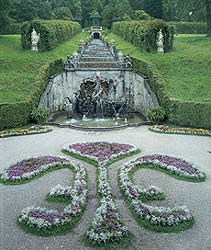“Crazy” King Ludwig II built several lovely palaces in Europe. He was particularly known for his eccentricity and his castles’ luxurious appointments. Linderhof, situated in Germany’s Bavaria, was based upon the exquisite Palace of Versailles in Paris, France. King Ludwig II, a shy man, also built the fairytale Neuschwanstein Castle as his private haven. Herrenchiemsee is his third, built on an island in the Chiemsee lake. A fourth, Falkenstein, was planned but never built.

Linderhof is by far the smallest, but likely the most opulent, of King Ludwig’s castles. As with most lovely gardens, a stately home anchors the setting. The surrounding garden landscape, under the care of six gardeners, stretches over 125 acres. The property contains several different formal gardens. The water parterre is in the front of the palace and contains a stately fountain that shoots water more than 25 feet high into the air. Visit the 300-year-old Linden Tree after which the palace was named.

The colorful Venus Grotto is a gorgeous indoor water garden “room” based on the First Act of Wagner’s “Tannhäuser”. King Ludwig liked to be rowed over the lake in his golden swan boat which is an artwork in itself. The grotto could be illuminated in several different colors — a novelty at the time. Being a shy, private man, King Ludwig liked to talk to “imaginary” prominent dinner guests at his lavish meals — one basis for the “crazy” indication.

With the Baroque design of the parterres, the Renaissance-style terraces and the landscape park based on ideas from England, together with elements from historic gardens such as Marly le Roi in France or La Granja in Spain, Linderhof is one of the finest existing examples of the mixed style of garden. (Courtesy linderhof.de)

It’s recommended that you stay at a hotel or hostel in Munich, Germany and then take public transportation or drive to Linderhof. You can take the Deutsche Bahn train to Oberammergau and then from there take a bus connection to Linderhof. European train and bus lines are the easiest way to travel and are almost always on time to the minute — so don’t be late for your departure time. Germany is a rainy country so be sure to bring appropriate clothing. Also, it can be cooler on cloudy days than expected.
Bavaria is known for its comforting foods such as Wienerschnitzel, bratwurst, and spatzle. Plan your trip in the fall and visit Oktoberfest in Munich where you can sample many European beers. Additionally, French, Indian, Chinese, Japanese, Spanish, and even Mexican restaurants are located in Munich. You won’t go wrong sampling the local food.
During the winter holiday season, visit the various Christkindlmarkets held across Europe. You can taste local holiday specialties such as Gluhwein and Lebkuchen.
For a list of additional German castles to see during your trip, visit the Bavarian Palace Department. You will see that Germany is full of neat old castles to visit. Some have been renovated and retained in their old glory and others are mere shells — yet all have history and even surrounding gardens to view.

Leave a Reply
You must be logged in to post a comment.